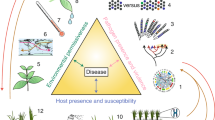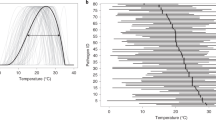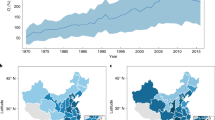Abstract
Crop pathogens and pests reduce the yield and quality of agricultural production. They cause substantial economic losses and reduce food security at household, national and global levels. Quantitative, standardized information on crop losses is difficult to compile and compare across crops, agroecosystems and regions. Here, we report on an expert-based assessment of crop health, and provide numerical estimates of yield losses on an individual pathogen and pest basis for five major crops globally and in food security hotspots. Our results document losses associated with 137 pathogens and pests associated with wheat, rice, maize, potato and soybean worldwide. Our yield loss (range) estimates at a global level and per hotspot for wheat (21.5% (10.1–28.1%)), rice (30.0% (24.6–40.9%)), maize (22.5% (19.5–41.1%)), potato (17.2% (8.1–21.0%)) and soybean (21.4% (11.0–32.4%)) suggest that the highest losses are associated with food-deficit regions with fast-growing populations, and frequently with emerging or re-emerging pests and diseases. Our assessment highlights differences in impacts among crop pathogens and pests and among food security hotspots. This analysis contributes critical information to prioritize crop health management to improve the sustainability of agroecosystems in delivering services to societies.
This is a preview of subscription content, access via your institution
Access options
Access Nature and 54 other Nature Portfolio journals
Get Nature+, our best-value online-access subscription
$29.99 / 30 days
cancel any time
Subscribe to this journal
Receive 12 digital issues and online access to articles
$119.00 per year
only $9.92 per issue
Buy this article
- Purchase on Springer Link
- Instant access to full article PDF
Prices may be subject to local taxes which are calculated during checkout



Similar content being viewed by others
Data availability
The anonymized survey data that support the findings of this study are available from the corresponding author upon reasonable request.
References
Crop Protection Compendium, https://www.cabi.org/cpc (CABI, 2018).
Strange, R. & Scott, P. R. Plant disease: a threat to global food security. Annu. Rev. Phytopathol. 43, 83–116 (2005).
Savary, S., Teng, P. S., Willocquet, L. & Nutter, F. W. Quantification and modeling of crop losses: a review of purposes. Annu. Rev. Phytopathol. 44, 89–112 (2006).
Esker, P., Savary, S. & McRoberts, N. Crop loss analysis and global food supply: focusing now on required harvests. CAB Rev. 7, 1–14 (2012).
Savary, S. et al. Crop health and its global impacts on the components of food security. Food Secur. 9, 311–327 (2017).
The State of Food Insecurity in the World 2013. The Multiple Dimensions of Food Security (IFAD, WFP & FAO, 2013).
Rausher, M. D. Co-evolution and plant resistance to natural enemies. Nature 411, 857–864 (2001).
McDonald, B. A. & Linde, C. Pathogen population genetics, evolutionary potential, and durable resistance. Annu. Rev. Phytopathol. 40, 349–379 (2002).
Zhan, J., Thrall, P. H. & Burdon, J. J. Achieving sustainable plant disease management through evolutionary principles. Trends Plant Sci. 19, 570–575 (2014).
Zadoks, J. C. & Schein, R. D. Epidemiology and Plant Disease Management (Oxford Univ. Press, New York, 1979).
Browning, J. A. Relevance of knowledge about natural ecosystems to development of pest management programs for agro-ecosystems. Proc. Am. Phytopathol. Soc. 1, 191–199 (1974).
Way, M. J. & Heong, K. L. The role of biodiversity in the dynamics and management of insect pests of tropical irrigated rice—a review. Bull. Entomol. Res. 84, 567–587 (1994).
Matson, P. A., Parton, W. J., Power, A. G. & Swift, M. J. Agricultural intensification and ecosystem properties. Science 277, 504–509 (1997).
Vitousek, P. M., Mooney, H. A., Lubchenco, H. A. & Melillo, J. M. Human domination of Earth’s ecosystems. Science 277, 494–499 (1997).
Cassman, K. G. et al. in Ecosystems and Human Well-Being: Current State and Trends Vol. 1 741–789 (Island Press, Washington, DC, 2005).
Foley, J. A. et al. Solutions for a cultivated planet. Nature 478, 337–342 (2011).
Hazell, P. & Wood, S. Drivers of change in global agriculture. Phil. Trans. R. Soc. Lond. B 363, 495–515 (2008).
West, P. C. et al. Leverage points for improving global food security and the environment. Science 345, 325–328 (2014).
Zhan, J. & McDonald, B. A. Experimental measures of pathogen competition and relative fitness. Annu. Rev. Phytopathol. 51, 131–153 (2013).
McDonald, B. A. & Stukenbrock, E. H. Rapid emergence of pathogens in agro-ecosystems: global threats to agricultural sustainability and food security. Phil. Trans. R. Soc. Lond. B 371, 20160026 (2016).
Anderson, P. K. et al. Emerging infectious diseases of plants: pathogen pollution, climate change and agrotechnology drivers. Trends Ecol. Evol. 19, 535–544 (2004).
Paini, D. R. et al. Global threat to agriculture from invasive species. Proc. Natl Acad. Sci. USA 113, 7575–7579 (2016).
Bebber, D. P., Holmes, T. & Gurr, S. J. The global spread of crop pests and pathogens. Glob. Ecol. Biogeogr. 23, 1398–1407 (2014).
Bebber, D. P., Holmes, T., Smith, D. & Gurr, S. J. Economic and physical determinants of the global distributions of crop pests and pathogens. New Phytol. 202, 901–910 (2014).
Savary, S., McRoberts, N., Esker, P. D., Willocquet, L. & Teng, P. S. Production situations as drivers of crop health: evidence and implications. Plant Pathol. 66, 867–876 (2017).
Waller, J. M., Lenné, J. M. & Waller, S. J. Plant Pathologist’s Pocketbook (CABI, Wallingford, UK, 2002).
Chiarappa, L. Crop Loss Assessment Methods. FAO Manual on Evaluation and Prevention of Losses by Pests, Disease and Weeds (Commonwealth Agricultural Bureaux, Buckinghamshire, UK, 1971).
James, W. C. & Teng, P. S. in Advances in Applied Biology Vol. 3 (ed. Coaker, T. H.) 201–267 (Academic Press, London, 1979).
Teng, P. S. Crop Loss Assessment and Pest Management (APS Press, St. Paul, MN, USA, 1987).
Heesterbeek, J. A. P. & Zadoks, J. C. Modelling pandemics of quarantine pests and diseases: problems and perspectives. Crop. Prot. 6, 211–221 (1987).
Cramer, H. H. Plant Protection and World Crop Production (Bayer, Leverkusen, Germany, 1967).
Oerke, E. C. Crop losses to pests. J. Agric. Sci. 144, 31–43 (2006).
Oerke, E. C., Dehne, H. W., Schönbeck, F. & Weber, A. Crop Production and Crop Protection: Estimated Losses in Major Food and Cash Crops (Elsevier Science, Amsterdam, 1994).
Savary, S., Elazegui, F. A. & Teng, P. S. Assessing the representativeness of data on yield losses due to rice diseases in tropical Asia. Plant Dis. 82, 705–709 (1998).
FAOSTAT (Food and Agriculture Organization of the United Nations, 2018); http://www.fao.org/faostat/en
Nelson, A. D. et al. Crop pests: crop-health survey aims to fill data gaps. Nature 541, 464 (2017).
Greenacre, M. J. Theory and Applications of Correspondence Analysis (Academic Press, London, 1984).
Savary, S., Madden, L. V., Zadoks, J. C. & Klein-Gebbinck, H. W. Use of categorical information and correspondence analysis in plant disease epidemiology. Adv. Bot. Res. 21, 213–240 (1995).
Hill, M. O. Correspondence analysis: a neglected multivariate method. Appl. Stat. 23, 340–354 (1974).
Lebart, L., Morineau, A. & Fénelon, J. P. Traitement des Données Statistiques. Méthodes et Programmes (Dunod, Paris, 1982).
Benzécri, J. P. L’Analyse des Données. Tome 2. L’Analyse des Correspondances (Dunod, Paris, 1973).
Breman, H. & De Wit, C. T. Rangeland productivity and exploitation in the Sahel. Science 221, 1341–1347 (1983).
Zadoks, J. C. in Crop Loss Assessment Methods (ed. Chiarappa, L.) 5–11 (CAB/FAO, Rome, 1981).
Van Velthuizen, H. et al. Mapping Biophysical Factors that Influence Agricultural Production and Rural Vulnerability (FAO, 2007).
Mueller, N. D. et al. Closing yield gaps through nutrient and water management. Nature 490, 254–257 (2012).
Haefele, S. M., Nelson, A. & Hijmans, R. J. Soil quality and constraints in global rice production. Geoderma 235–236, 250–259 (2014).
Godfray, H. C. J. et al. Food security: the challenge of feeding 9 billion people. Science 327, 812–818 (2010).
Lim, S. S. et al. A comparative risk assessment of burden of disease and injury attributable to 67 risk factors and risk factor clusters in 21 regions, 1990–2010: a systematic analysis for the Global Burden of Disease Study 2010. Lancet 380, 2224–2260 (2012).
International Newsletter on Plant Pathology: ISPP Newsletter 46 (11) November 2016 (ISPP, 2016); http://www.isppweb.org/newsletters/pdf/46_11.pdf
International Newsletter on Plant Pathology: ISPP Newsletter 46 (12) December 2016 (ISPP, 2016); http://www.isppweb.org/newsletters/pdf/46_12.pdf
International Newsletter on Plant Pathology: ISPP Newsletter 47 (1) January 2017 (ISPP, 2017); http://www.isppweb.org/newsletters/pdf/47_1.pdf
Kottek, M., Grieser, J., Beck, C., Rudolf, B. & Rubel, F. World map of the Köppen–Geiger climate classification updated. Meteorol. Z. 15, 259–263 (2006).
Rubel, F., Brugger, K., Haslinger, K. & Auer, I. The climate of the European Alps: shift of very high resolution Köppen–Geiger climate zones 1800–2100. Meteorol. Z. 26, 115–125 (2017).
Hijmans, R. Global Administrative Areas Database (GADM) Version 3.6, http://www.gadm.org (University of California Berkeley, Berkeley, CA, USA, 2018).
You, L. et al. Spatial Production Allocation Model (SPAM) 2005 Version 3.2, http://mapspam.info (IFPRI, Washington, DC, 2017).
Gilligan, C. A. & van den Bosch, F. Epidemiological models for invasion and persistence of pathogens. Annu. Rev. Phytopathol. 46, 385–418 (2008).
Shaw, M. W. Simulation of population expansion and spatial pattern when individual dispersal distributions do not decline exponentially with distance. Proc. Biol. Sci. 259, 243–248 (1995).
Jeger, M. J., Pautasso, M., Holdenrieder, O. & Shaw, M. W. Modelling disease spread and control in networks: implications for plant sciences. New Phytol. 174, 279–297 (2007).
Shaw, M. W. & Osborne, T. M. Geographic distribution of plant pathogens in response to climate change. Plant Pathol. 60, 31–43 (2011).
Lo Iacono, G., van den Bosch, F. & Gilligan, C. A. Durable resistance to crop pathogens: an epidemiological framework to predict risk under uncertainty. PLoS Comput. Biol. 9, e1002870 (2013).
Fitt, B. D. L., Gregory, P. H., Todd, A. D., McCartney, H. A. & Macdonald, O. C. Spore dispersal and plant disease gradients; a comparison between two empirical models. J. Phytopathol. 118, 227–242 (1987).
Benzécri, J. P. L’Analyse des Données. Tome 1. La Taxinomie (Dunod, Paris, 1973).
Wilkinson, L., Engelman, L., Corter, J. & Coward, M. in Statistics I 223–302 (Systat Software, Chicago, 2009).
Lê, S., Josse, J. & Husson, F. FactoMineR: an R package for multivariate analysis. J. Stat. Softw. 25, 253–258 (2008).
Pfeffermann, D. The use of sampling weights for survey data analysis. Stat. Methods Med. Res. 5, 239–261 (1996).
Padwick, G. W. Losses Caused by Plant Diseases in the Tropics Phytopathology Paper No. 1 (Commonwealth Mycological Institute, 1956).
Statistical Year Book India 2016 (MOSPI, 2017); http://www.mospi.gov.in/statistical-year-book-india/2016/177
The Soybean Processors Association of India Databank (SOPA, 2016); http://www.sopa.org/statistics
United States Department of Agriculture National Agricultural Statistics Service (USDA, 2017); https://www.nass.usda.gov
Agricultural Production Crop Statistics (Eurostat, 2017); https://ec.europa.eu/eurostat/data/database
Instituto Brasileiro de Geografia e Estatística (IBGE, 2016); https://downloads.ibge.gov.br/downloads_estatisticas.htm
Bockus, W. W., Bowden, R. L., Hunger, R. M., Murray, T. D. & Smiley, R. W. Compendium of Wheat Diseases and Pests (APS Press, St. Paul, MN, USA, 2010).
Wiese, M. V. Compendium of Wheat Diseases (APS Press, St. Paul, MN, USA, 1987).
Ou, S. H. Rice Diseases (CABI, Slough, UK, 1985).
Pathak, M. D. Insect Pests of Rice (IRRI, Los Baños, Phillipines, 1977).
White, D. G. Compendium of Corn Diseases (APS Press, St. Paul, MN, USA, 1999).
Stevenson, W. R., Loria, R., Franc, G. D. & Weingartner, D. P. Compendium of Potato Diseases (APS Press, St. Paul, MN, USA, 2001).
Hartman, G. L. et al. Compendium of Soybean Diseases and Pests (APS Press, St. Paul, MN, USA, 2015).
Turechek, W. W. & McRoberts, N. Considerations of scale in the analysis of spatial pattern of plant disease epidemics. Annu. Rev. Phytopathol. 51, 453–472 (2013).
Thies, C. & Tscharntke, T. Landscape structure and biological control in agroecosystems. Science 285, 893–895 (1999).
Yuen, J. & Mila, A. Landscape-scale disease risk quantification and prediction. Annu. Rev. Phytopathol. 53, 471–484 (2015).
Parratt, S. R., Numminen, E. & Laine, A.-L. Infectious disease dynamics in heterogeneous landscapes. Annu. Rev. Ecol. Evol. Syst. 47, 283–306 (2016).
Savary, S., Willocquet, L., Elazegui, F. A., Castilla, N. P. & Teng, P. S. Rice pest constraints in tropical Asia: quantification of yield losses due to rice pests in a range of production situations. Plant Dis. 84, 357–369 (2000).
Savary, S. et al. Rice pest constraints in tropical Asia: characterization of injury profiles in relation to production situations. Plant Dis. 84, 341–356 (2000).
Acknowledgements
The authors are grateful to the ISPP for help in reaching out to experts for the survey and for permission to reprint the information in Supplementary Note 2. The authors thank all experts (Supplementary Table 1) who have contributed to the online survey. All interpretations of the survey information are the sole responsibility of the authors. N.M. was partly supported by USDA-NIFA project CA-D-PPA-2131-H.
Author information
Authors and Affiliations
Contributions
S.S., L.W., A.N., S.J.P., P.E. and N.M. designed the survey. A.N. and S.S. implemented the online survey. A.N. retrieved and assembled the climatic, population and crop production data. S.S., L.W. and A.N. analysed the data. S.S., L.W., A.N., S.J.P., P.E. and N.M. interpreted the data and results of the analyses. S.S., A.N. and L.W. wrote the article. S.J.P., P.E. and N.M. reviewed all elements of the article.
Corresponding author
Ethics declarations
Competing interests
The authors declare no competing interests.
Additional information
Publisher’s note: Springer Nature remains neutral with regard to jurisdictional claims in published maps and institutional affiliations.
Supplementary information
Supplementary Information
Supplementary Figs. 1–4, Supplementary Tables 1–6, Supplementary Notes 1 and 2 and Supplementary References
Rights and permissions
About this article
Cite this article
Savary, S., Willocquet, L., Pethybridge, S.J. et al. The global burden of pathogens and pests on major food crops. Nat Ecol Evol 3, 430–439 (2019). https://doi.org/10.1038/s41559-018-0793-y
Received:
Accepted:
Published:
Issue Date:
DOI: https://doi.org/10.1038/s41559-018-0793-y
This article is cited by
-
Lipid mediated plant immunity in susceptible and tolerant soybean cultivars in response to Phytophthora sojae colonization and infection
BMC Plant Biology (2024)
-
Management of the Striga epidemics in pearl millet production: a review
CABI Agriculture and Bioscience (2024)
-
Apiospora arundinis, a panoply of carbohydrate-active enzymes and secondary metabolites
IMA Fungus (2024)
-
Sulfonate derivatives bearing an amide unit: design, synthesis and biological activity studies
BMC Chemistry (2024)
-
Wheat powdery mildew resistance gene Pm13 encodes a mixed lineage kinase domain-like protein
Nature Communications (2024)



